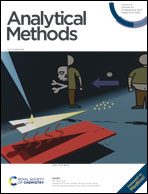Construction of a liquid crystal biosensor based on Fe3O4 nano-signal amplification and its application in HCG detection†
Abstract
In this research, to improve the ability of nanomaterials to interfere with liquid crystal orientation, we constructed a novel liquid crystal biosensor using Fe3O4 nanospheres as signal amplifiers, which was used for the highly selective and sensitive detection of human chorionic gonadotropin (HCG). The Fe3O4 nanospheres in liquid crystal biosensors are still rare, in particular for the detection of the HCG antigen, a marker of pregnancy in women. This strategy takes advantage of the large spatial structure of Fe3O4 nanospheres to pre-immobilise β-hCG antibodies on the glass substrate, and, in the presence of HCG antigens, the antigen–antibody formed a specific immune response to disrupt the orientation of the liquid crystal. This allows an amplified optical signal to be generated for the ultimate successful detection of HCG antigen, and can greatly reduce the detectability of the target antigen concentration, ultimately greatly increasing the sensitivity of detection to a large degree. Thus, under optimal detection conditions, the minimum detection limit can be as low as 0.438 mIU mL−1. The prepared LC biosensor demonstrates excellent specificity and sensitivity compared to conventional nanomaterials used in liquid crystal biosensors, and will be of great benefit for future applications requiring trace detection of proteins, antibiotics, bacteria and so on, which is expected to provide a sensitive detection platform for HCG and other molecular monitors.



 Please wait while we load your content...
Please wait while we load your content...